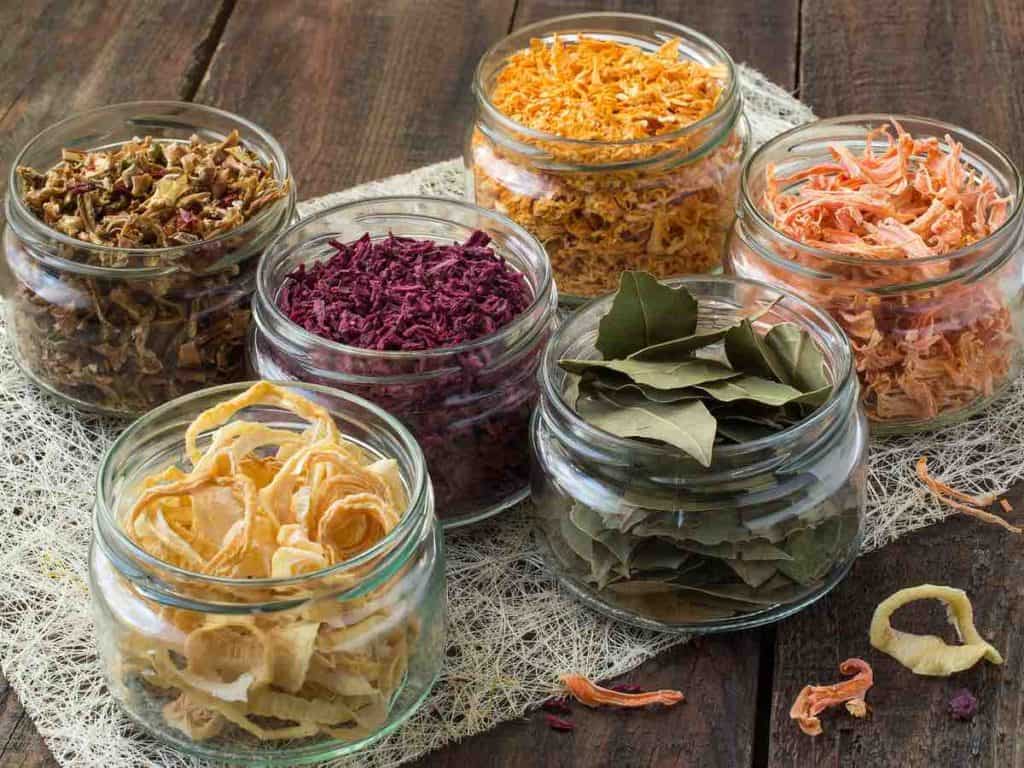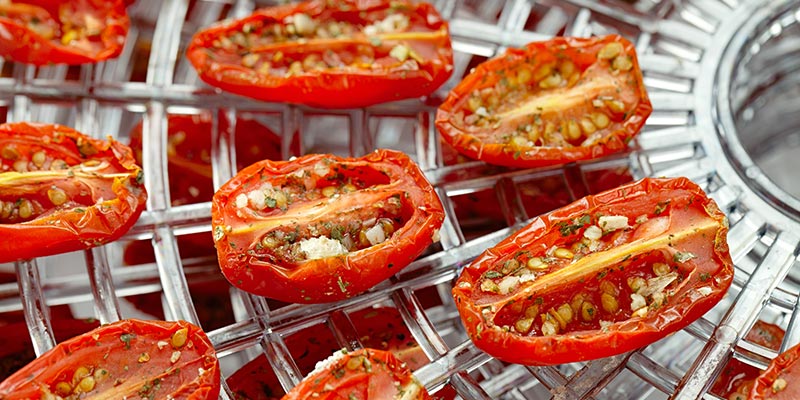Dehydration is the world’s oldest method of food preservation, requires no preservatives, and produces food that tastes great and has a shelf life of months. There are many good reasons to add food dehydration to your DIY skills. Here’s everything you need to know about dehydrated foods.
Table of Contents
What’s Food Dehydration?
Food dehydration involves removing water and moisture from vegetables, fruits, meat, and fish by using a dehydrator, oven, or sun drying. This helps prevent the growth of microorganisms such as yeast, mold, and bacteria and preserves food for future use while maintaining nutritional integrity.

Food has been dehydrated since prehistoric times, and seeds were dried in the sun for later consumption. There is evidence that food has been sun-dried in Middle Eastern and Eastern civilizations as early as 12,000 BC. Indians sun-dried meat, Japanese sun-dried fish and rice, and Chinese sun-dried eggs.
However, given the focus on fast food these days, people are either too trusting in food companies or too busy with their own business to think about what additives and preservatives are added to burgers, what are french fries made of, what food is how to prepare, etc.
Read More: How to Dehydrate Onions?
Common Types of Food Dehydration
Preserving your own food means being able to control almost every aspect of the food you eat, including its quality. There are many ways to preserve food through dehydration. Easier methods to use include sun drying and oven drying. Of course, food preservation enthusiasts rely on stand-alone dehydrators.
Sun Dry
If you want to try sun drying, fruits are your best bet because they are high in sugar and acid. This means they are not as prone to spoilage during processing as vegetables. Sun-dried meat, on the other hand, may lead to bacterial growth because it is high in protein.
How long does it take to dry fruit? For example, tomatoes take about 10 to 14 days. Depending on your recipe, you can add salt, red wine, or ascorbic acid to the fruit before drying it.
Oven Dry
You need to consider your oven type. If it’s running on electricity, you should keep in mind that it has to be on for a few hours. So this may not be cost-effective depending on where you live. Also, you need to keep the oven door slightly open to remove moisture. This will make your room feel warmer, although it’s a great source of extra heat during the colder months.
Use a Food Dehydrator
Once you get used to dehydrating food, you may want to invest in a dehydrator. Unlike ovens, dehydrators do not destroy food enzymes. It also allows for thorough drying. There is also an advantage of being more energy-efficient, which should translate into greater savings. By the way, you don’t need to check the dehydrator as often as it is safer to use.
Benefits of Dehydrating Food

- 1. Dehydrated food tastes good
Use a food dehydrator to remove water from foods like fruits, vegetables, and meats to create naturally concentrated, rich, delicious foods.
Not only that, but when you make your own food, you know the quality and freshness of the product you’re using – unlike eating dehydrated foods bought from the grocery store.
- 2. Reduce food waste and extend shelf life
Stop wasting food with a food dehydrator. Using your leftover fruit in a food dehydrator will extend its shelf life by up to 2 years! Yes, that’s right – 2 years!
Here are some ways you can reduce food waste by using a dehydrator to preserve food and keep your pantry stocked year-round while saving yourself some money in the process;
Manage a larger vegan or herb garden without worrying about food waste – just use a dehydrator to dry your herbs or make vegan chips. Some vegetables that work well in a dehydrator include kale, beetroot, turnips, carrots, sweet potatoes, and even green beans.
Save foods that would otherwise go bad, like forgotten fruit in the back of the fridge, and turn them into delicious and healthy treats and snacks like fruit peels.
Dehydrated foods can also be simply “rehydrated” with water or added to soups, casseroles, stews, or pasta sauces.
- 3. Create healthy 100% natural food
Dehydrated food only needs one ingredient, the food you are drying, so not only is it 100% natural, but you benefit from all the minerals and fiber of the whole fruit, unlike cooking and steaming, you don’t lose what you are Dehydrated foods contain any nutrients.
Dehydration changes the way you look at food. Simple fruits and vegetables can be turned into delicious, healthy snacks and treats. Healthy alternatives to junk food can be made in a dehydrator, and the possibilities are endless! You might be surprised by the amount of food you eat that is actually dry and you can make your own – sultanas, dried herbs, dates, etc.
When we think of dried fruit, we tend to associate it with “healthy snacks”. Many times when people are dieting, they consume dried fruit in large quantities, thinking it is a healthy alternative to candy or lollipops. However, this is not the case when it comes to store-bought dried fruit. Many store-bought dried fruits contain added sugars, sulfur dioxide, and trans fats—all of which can be bad for you and your family!
Sulfur dioxide is sometimes added to store-bought dried fruit to prevent discoloration. Sulfur dioxide can cause asthma, rashes, and stomach pains. Sulfur dioxide is especially present in dried apricots, which give dried apricots their bright orange color.
By making your own dried fruit, with no additives or preservatives – you can control the ingredients in your food! If you’re tired of not being able to give your kids and family healthy snacks, a food dehydrator is your answer.
- 4. Cost saving
Processed, store-bought snacks can be expensive, and organic dehydrated foods are often overpriced. You can save a lot of money by using your own food dehydrator, buying fresh in bulk during peak season, or harvesting your own produce.
Take advantage of deals at your local grocery store or farmers’ market, and remember to dehydrate your food and store it.
- 5. Efficient storage
Dry food takes up less than one-sixth of its original storage space and doesn’t require the constant power draw of a refrigerator or freezer. Simply pack food in clean, dry, insect-proof containers or canning jars, plastic freezer containers with tight-fitting lids, plastic freezer bags, or vacuum-sealed bags (single-size) and store them in your pantry for the best snack.
This dramatic reduction in size means you can fit a lot of preserves in a small area, which is especially ideal for camping, hiking, and large families.
- 6. Portability
Dehydrated foods are compact, lightweight, and travel-friendly.
As mentioned, healthy foods and snacks can be expensive, and you can’t always find or get them on the go. By dehydrating food at home, you can make the perfect snack for your child’s school lunch box, or a midday hunger buster for you on the road or at work.
- 7. Precision drying
If you’ve ever tried to dehydrate food in the oven, then you understand the frustration it can sometimes bring – not only because you have to pay higher electricity bills, but because most home ovens are even below 90 degrees Celsius. Won’t start the thermometer! Instead, by using a food dehydrator, you have complete control over drying foods at lower temperatures.
Because of these low temperatures, foods prepared with dehydrators are often considered “raw foods.” A raw food diet has many benefits and is said to preserve the active nutrients and enzymes in fruits and vegetables, while the heating process is said to eliminate or deplete these nutrients and enzymes from the food.
Subsequently, if you’re eating raw food, or just want to eat more raw food, a dehydrator provides a great alternative for preparing food at temperatures below 46 degrees Celsius, rather than any other kitchen appliance on the market. 46 degrees Celsius is the threshold temperature for maintaining enzymes and nutrients.
- 8. Flexible and diverse
Whether you want to make fruit peels, activate some nuts, or make a batch of veggie crisps, a food dehydrator gives you the flexibility to do all of this—plus, you can choose to run the machine for hours or days!
- 9. Simple and easy to use
So easy to use, the food dehydrator is basically foolproof! With this easy set-and-forget system, you just slice the food, place it on the tray, set the timer, and go. It’s that simple!
Also, you’ll be excited to know that with the temperature set so low it’s almost impossible to overdraw your food, and if you do, you can always use a little water or add them to soups, casseroles, stews Or “rehydrate” in pasta sauces.
- 10. Safe storage – extremely low risk of bacteria and spoilage
Unlike other preservation methods, because the food dehydrator removes moisture from the food during the drying process, the risk of bacterial growth or spoilage is very low. In fact, dehydration is a common preservation method for campers, hikers, and even astronauts because of its safety!
Conclusion
Dehydrated foods can keep you healthy enough to keep you healthy for a long time. By replacing snacks with dried fruits and vegetables, you can enjoy delicious snacks and recipes while maintaining a healthier lifestyle. With the help of a good dehydrator, you can easily and conveniently get the doses of nutrients, minerals, and antioxidants you need.

